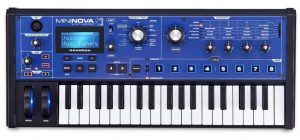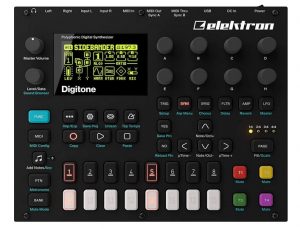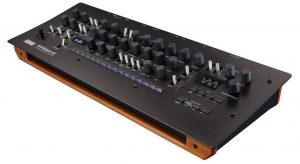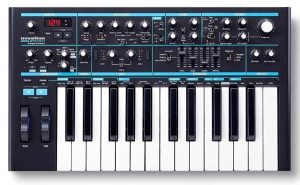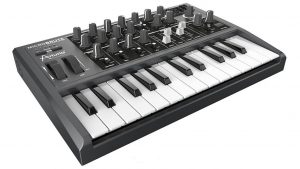The Synth is an excellent instrument to create one’s unique sound and can be of much help in crafting music for a brand. With the rise of plugin software synths, the analog synthesizer has become a luxury item for music producers. Though software synths are capable of creating rich experiences with sounds, analog synths are also capable of deriving originality with music. Music producers are much drawn towards analog synths, owing to the rich tactile experience they provide. So, here we are sharing the top 5 best synths under $1000 rated by experts.
Quick Summary: Best Synths Under $1000
Also check: Best Synthesizer Keyboards for Live Performance
Top 5 Best Synthesizers Under $1000
The analog modeling technology has advanced much better, thus it is virtually impossible to quote the difference between analog processors and digital processors. We have made our research in picking up the best synths from both worlds here to help you find the best instrument that complements your music journey. Here are the top 5 best synths under $1000.
#1. Novation AMS-MiniNova Analog Synthesizer – Best Overall
| Features | Rating |
| Performance and sounds | 9.1 |
| Connectivity | 8.8 |
| Build Quality | 9.1 |
| Easy to Use | 8.7 |
| Value for money | 9.3 |
This is an excellent mini-synth that is equipped with a nova sound engine. This is an eminent vocoder with a unique pitch-correcting effect and Vocal Tune helping players to tweak and warp sounds in real time. This analog synth has 256 awesome onboard sounds along with additional free sound packs that can be downloaded upon registration. It also comes with 30 Giorgio Moroder-inspired patches that help players to layer up to five effects per voice.
This is a compact and super cool studio and lives synth device that comes with three years warranty. The Mininova synth sounds just like its big brother ultraNova. The synth has about 18 voices and five synth effects on each sound. It also features an onboard VocalTune effect and a classic vocoder to help recreate iconic vocal sounds from urban, hip-hop, and electronic music. Though it is small in size, it is a powerful sound engine that helps to create and edit massive bass sounds, lush pads, and vintage synth sounds.
It comes pre-loaded with editing software to create powerful synths. Its editor works as a plug-in within the music software, which can be learned through its visual access. There are around 14 conventional waveforms to choose from in this synth along with 36 wavetables and 20 digital waveforms. There are 3 oscillators per voice with detune and density for fattening up the sounds.
What’s best in Novation AMS-MiniNova Analog Synthesizer?
- This is a 37 mini-key synth with a USB and MIDI port.
- Features 256 onboard sounds with space to save another 128 sounds.
- It is possible to tweak and warp sounds in real-time
- The synth allows for instant editing and performance control with access to 24 sound-bending parameters.
What’s Lacking in Novation AMS-MiniNova Analog Synthesizer?
- Being a mini keyboard, it doesn’t appeal to novice keyboard players
- It doesn’t have a full-sized set of keys for general recording.
Also Check: Best Budget Synths Under $500
#2. Elektron Digitone EKT-DTN-1 Synthesizer – Best for Starters
| Features | Rating |
| Performance and sounds | 9.3 |
| Connectivity | 8.7 |
| Build Quality | 8.6 |
| Easy to Use | 8.8 |
| Value for money | 9.2 |
This is an excellent synth that is available for under $1000. It features excellent FM sound generation with classic subtractive synthesis signal flow. It features multiple FM algorithms that feature carefully selected parameters and are packed with grade-A factory content. The best features of this synthesizer are its OLED screen and its sturdy steel casing. The synth features a panoramic chorus, supervoid reverb, and saturator delay with effects.
The synthesizer combines a deep FM synthesis with a familiar synthesis signal flow. This is a powerful 8-voice synth with four independent tracks, each with a four-operator synth engine, that features eight different FM algorithms. This sequencer features four synth tracks, 4 MIDI tracks, one arpeggiator per track, polyphonic sequencing, micro timing, parameter locks, etc. The synth also features 8 voice polyphony, multiple FM algorithms, and two assignable LFOs per voice.
The Elektron over bridge helps the players to integrate the digitone synth and sequencer right into the DAW, helping to route audio to and from the hardware, with the help of a single USB cable. The users will have a complete graphical user interface to control major aspects of the Digitone. The sequencer also supports micro-timing adjustments for creating excellent sequences.
What’s best in Elektron Digitone EKT-DTN-1 Synthesizer?
- The digitone is a unique box that creates excellent sounds in less than a second
- Users are free to choose from multiple FM algorithms from carefully selected parameters.
- We can shape the tones with powerful filters and arrange them with the help of a powerful Elektron sequencer.
- There are four synth tracks, 4 MIDI tracks, and one arpeggiator per track along with polyphonic sequencing in this synth.
What’s Lacking in Elektron Digitone EKT-DTN-1 Synthesizer?
- Its hardware is not impressive for advanced and professional players.
Also check: Best Synths for Hip Hop: Top 5 Picks
#3. Korg Minilogue XD 4-Voice Analog Synthesizer – Editor’s Choice
| Features | Rating |
| Performance and sounds | 9.1 |
| Connectivity | 8.7 |
| Build Quality | 8.9 |
| Easy to Use | 8.6 |
| Value for money | 9.1 |
This is an excellent four-voice analog and digital synthesizer module that features two VCOs per voice. It features a digital multi-engine and sixteen-step polyphonic sequencer with four voice modes and tremendous effects. It has several new features, inspired by the prologue and the monologue, and includes the same circuitry and micro-tuning abilities with its new sequencer.
Though this synthesizer is similar to the original Minilogue, features a lot of new additions to its interface, such as an assignable joystick, a 16-step sequencer, and a lot of additional switches and knobs. One best feature of the prologue is its digital oscillator that can be used to create next-level textures and sounds. The instrument also has improved the display and the waveforms and has made it much crisper and sharper than before.
The synthesizer features a new multi-effect section that allows the players to stack three different effects together such as the delay, reverb, chorus, flanger, phaser, ensemble, etc., allowing players to create lush and wide sounds with ample movements. The Korg Minilogue XD is one of the easiest instruments to play and program and its results are also of very high quality. In short, this can be an excellent synth for those looking for a well-built, versatile, and easy-to-use synth with warm analog sounds and modern technology.
What’s best in Korg Minilogue XD 4-Voice Analog Synthesizer?
- This analog synth is powerful, compact, and expert.
- Comes with the best hardware and it also sounds great.
- It is easy to program and extremely fun to use
- Excellent and built to create seriously awesome music
What’s Lacking in Korg Minilogue XD 4-Voice Analog Synthesizer?
- The synthesizer doesn’t ship with rack ears and the rack has to be bought separately and assembled.
#4. Novation Bass Station-II NOVSYNTH03 Mono Synth – Alternative Choice Under $1000
| Features | Rating |
| Performance and sounds | 8.9 |
| Connectivity | 8.8 |
| Build Quality | 8.5 |
| Easy to Use | 8.6 |
| Value for money | 9 |
This is an excellent analog synth and is a new version of the classic Novation bass station. It features a brand-new acid filter and ships with 64 factory patches and 64 user slots. This is indeed a pattern-based step sequencer that has two oscillators and an additional sub-oscillator. Being an expert analog synth, it comes with dedicated controls for all major music parameters.
The synth comes with full analog distortion and filter modulation effects and features a separate filter overdrive to add crunchy and aggressive sound quality. The product also comes with a three years warranty and is an expert mono synth with options for bass. Its sound engine is extremely versatile to generate sharp lead and crisp arpeggios. You can be sure to bring the best of the original base station with reworked effects, modulation, filters, and a lot more.
The signal path is completely analog, which includes the effects. Its hardware has special modules with dedicated pots, switches, sliders, and buttons for all major music parameters. This analog synth comes with around 64 factory presets, with enough space to record one’s sounds on the hardware. We can also shift the sounds to the computer. There are 25 full-sized velocity-sensitive keys assignable aftertouch. Being an excellent synth-action keyboard, each of its keys is individually sprung.
What’s best in Novation Bass Station-II NOVSYNTH03 Mono Synth?
- All its 25 keys are full-sized and are velocity-sensitive with assignable aftertouch.
- Its Bass station is compliant with MIDI devices and there are ports to connect with other USB and other MIDI devices.
- The bass station II is built over three analog oscillators and a noise generator.
- There are two discrete filters, namely acid and classic, each with a built-in overdrive to filter tones.
What’s Lacking in Novation Bass Station-II NOVSYNTH03 Mono Synth?
- It is a monophonic synth device that can play only one note at a time.
Also check: Best Synths for Ambient Music
#5. Arturia MicroBrute Analog Synthesizer – Ideal for Learners
| Features | Rating |
| Performance and sounds | 8.9 |
| Connectivity | 8.7 |
| Build Quality | 8.5 |
| Easy to Use | 8.7 |
| Value for money | 8.9 |
The Arturia MicroBrute features a 100% analog audio signal path that features a Steiner-Parker multimode filter. This is an excellent voltage-controlled oscillator with a new overtone. The Arturia is the next-generation synthesizer of the brute family and the successor of the miniature. Though this synthesizer is smaller in size, it is capable of retaining a pure analog sound and its oscillators help with tremendous waveshaping.
Its sounds are better than any analog synth that is available in the market, and it features a new step sequencer for generating exceptional sound patterns. This is an easy-to-use sequencer with an upgraded sub-oscillator. Its new sub-oscillator helps in adding an octave down to the music, along with the ability to mix harmonic sounds. Its Mod Matrix patch bay allows players to route three modulation sources such as LFO, ENV, and Keyboard CV to any of the six modulation destinations. Its semi-modular capabilities help in creating many powerful sounds.
Though this is the smallest synth machine, it is also the most powerful that is available in the market and it sets new standards for the analog synth at an exceptional price. You can even plug the guitar into this synth and make it function like a harmonizer or a vocoder. Players can save patterns and control them with midi. With the Arturia analog synthesizer at hand, the possibilities are endless and this is a highly recommended synth for novice players.
What’s best in Arturia MicroBrute Analog Synthesizer?
- The instrument has so much power and thus creates beautiful sounds both at low and high harmonic possibilities.
- Its control panel is easy to understand and navigate
- Its sequencer and rest button helps create interesting patterns with music.
What’s Lacking in Arturia MicroBrute Analog Synthesizer?
- The Arturia MicroBrute is not a MIDI controller
- Ideal synth for those who are trying to learn new synths and may not appeal to advanced players
Must Check: Yamaha MX61 Review 2024: Ideal Music Production Synthesizer?
How Should You Choose Your Best Synth When You Have Decided to Spend $1000?
The ability of the synths to produce nice warm music has become of the most desired qualities in modern electronic music. But before choosing your keyboard synths, here are the qualities you should check for, to do justice to the money spent on the device.
1. Monophonic or polyphonic
The monophonic synthesizers are capable of producing only one note at a time, whereas the polyphonic synthesizers can produce multiple notes at a time. Multiple notes are always the preferred option though the monophonic instruments allow for specific and preferred sounds.
2. Oscillators
It is the oscillator in the synthesizer that is capable of generating the sound that we hear. If the synth has more oscillators and options, then you will be able to clear a wide range of tones and sounds with the synthesizer. The oscillator also controls the shape of the sound wave generated.
3. Arpeggiator
The arpeggiator in the synth instrument helps create a running music pattern. It takes either a single note or a series of notes and creates a music pattern by latching them together. This is one of the best-known effects of the synthesizer and is also open for customization.
4. Tone modulation
The best feature of the synthesizer is the control it levies over the sound. We can adjust this modulation component to alter another aspect of the sound. It can be considered as a tool in a synthesizer that allows music creators to dial in a specific sound that they are trying to achieve.
5. Music filters
These filter music and allows certain sound waves to pass through and block others. Different filters will create different sound shapes and also shape the music tones.
6. Envelopes
They shape the sound that comes from the synth and makes it long, short, plucky, or even sustained. The envelope controls automation over one or more parameters and the most common type of envelope is its attack, sustain, decay, and release (ADSR) component that helps to control the shape and contour of the sound.
How To Set A Budget Before Purchasing A Digital Piano Or Synth?
- If you are just starting out and want to see if synthesizers are for you, get some free soft synths and a MIDI controller. It’ll be less expensive and allow you to experiment with different synthesis styles before investing in dedicated hardware.
- If you are prepared to make the switch to a physical synth, let’s lay the groundwork for your first purchase. For starters, there’s no need to spend more than $1,000; $400 will get you an outstanding instrument that you’ll enjoy playing for years.
- It is also strongly advised that you adhere to something that requires a keyboard. Although you could potentially get more synth for less money by ditching it (as with the Behringer Neutron), the dynamism of the keys will be appreciated when you are just starting out.
- Finally, it must be simple to use and capable of producing music rather than just noise. This is obviously subjective: one person’s noise would be another person’s symphony. But you most likely want to create more than bleeps, bloops, and drones. So, as intriguing as it is, the Volca Modular is no longer available. These instruments are far best suited as low-cost additions to an existing setup.
- Any keyboard does not wear out immediately. It provides visible indicators of potential problems. Some keys, for example, may not work properly. When you’ve identified these issues, you can proceed with the keyboard with a bit more effort. However, don’t be in a hurry to find a replacement.
- Another way to save money is to compare keyboard prices at different stores. However, only shop at reputable establishments. Examine the prices and quality of keyboards at every store carefully. Consider their shipping costs and warranty terms as well. Finally, choose a store that sells high-quality keyboards at reasonable prices.
What Are The Features of A Synth?
- A synthesizer is an electronic musical instrument that can generate sound by generating various signals. When we think of synthesizers, we usually envision a keyboard with complex patterns of knobs and buttons.
- One thing to avoid obsessing over is the number of sounds in a synth. There are 2 explanations for this. To begin with, synthesizers, by definition, can produce a wide range of sounds. Second, even low-cost synthesizers generally come with hundreds of factory-created “preset” sounds.
- Presets are just starting points for most synth owners. What matters is the way the synth enables the user to manipulate the sound. You should look for one with a plethora of knobs, dials, wheels, pedals, and faders, as these are the controls used to alter and communicate with sounds.
- Playing almost any instrument is an immensely tactile experience, so how a synth’s keyboard feels is critical. Light, non-weighted plastic keys have obvious advantages, but many players, especially those who are accustomed to playing acoustic or electric pianos with a heavy “action,” will prefer a weighted keyboard; that is, one which feels more solid under their fingers.
- Similarly, how the controls feel is just as essential as what they do. Again, this is largely an issue of personal preference; some players would prefer turning knobs to pushing buttons, while others prefer the opposite.
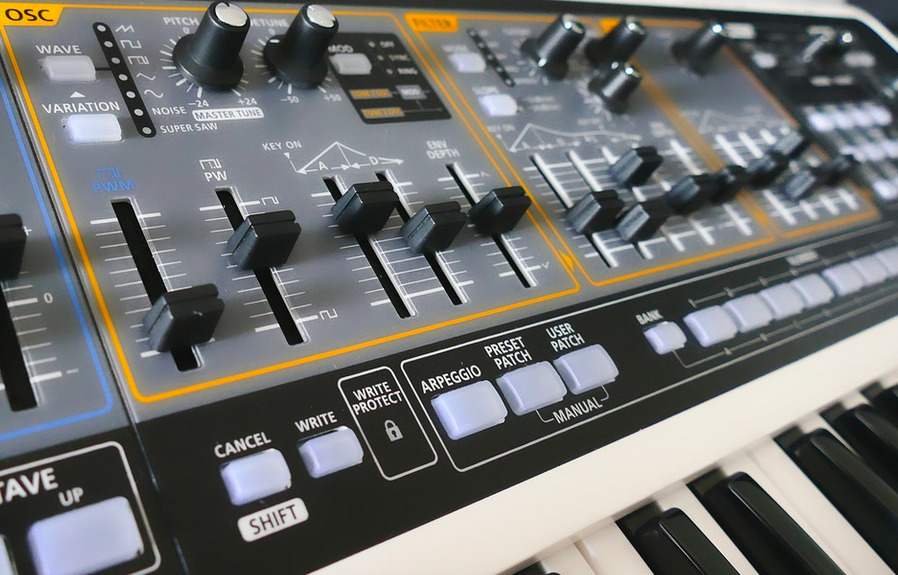
What Are The Factors That Add To The Cost Of A Musical Instrument Like A Piano Or A Synth?
- Your understanding of the instrument. There are various keyboards available for various needs, whether you are a novice, an intermediate player, or a professional.
- The keyboard’s price or your budget when buying this musical instrument. The features you want in your keyboard, such as the number of tones, rhythms, patterns, and so on.
- The amount of space users have in their house or studio. This will assist you in determining the best size for the keyboard.
- If portability is one of your top priorities. If you need something portable, opt for a lightweight or smaller keyboard. When evaluating the portability of your keyboard, you should consider both size and weight. You should also consider whether you want to create your own compositions or practice tunes from popular songs. This will assist you in selecting the appropriate keyboard after evaluating the connectivity features.
- Options for professional recording or going to practice your favorite tracks
- Storage option for recording and storing your audio tracks. Most professional keyboards are priced based on their memory capacity.
- The quantity of input and output points You can play at home, in a studio, in an auditorium, on a stage, or anywhere else.
- The audio quality is excellent. If you are looking for a keyboard for professional use, you should look for one with excellent audio quality. Whether or not you want to purchase a touch-sensitive keyboard. The intensity of the sound in these keyboards is determined by just how you push the keys whilst also playing a tune.
How Is A Synth Different From A Digital Piano Or Keyboard?
Synthesizers, unlike keyboards, can generate their own sounds.
Over the years, keyboards have evolved dramatically. They vary from the piano in that they are less heavy and have fewer notes with little resistance, making them far simpler to press. Unlike a piano, which requires both hands to work independently, a keyboard only requires a chord to be played or even just a single key on the left side to allow a built-in auto-accompaniment to play based on that note.
As you push a different note, the background music changes to reflect the new ‘chord,’ allowing you to manage the backing while playing the melody with your right hand. The higher the quality of a keyboard, the more realistic the sounds and accompaniment styles will be.
Synthesizers were created as the simplest basic way to imitate a real instrument with limited technology. These ‘analog’ synthesizers gained popularity and can be heard in so many iconic 1970s and 1980s tracks. Many synthesizers these days produce sounds in a variety of ways, and some even include a built-in library of multitudes of iconic voices that are ready to use right away.
However, unlike keyboards and organs, they do not have built-in accompaniment sounds and are usually utilized as a music production tool, whether live on stage or in the studio with the help of a dedicated synthesizer. A variety of sounds are available on the keyboard, including piano, organ, wind instruments, guitars, strings, choir voices, and synthetic sounds.
Furthermore, almost every keyboard on the market today supports automated accompaniments based on rhythms or styles. Play along by pressing a button to select the genre you want. Ordinarily, the chords are played with the left hand and the melody with the right, but the automated accompaniment follows the chords played.
Synthesizers are professional instruments used in the studio and on stage. A synthesizer is essentially a set of sounds created by the user or the manufacturer. The elegance of a synth is that you can adjust and tweak these sounds to your heart’s delight. Besides that, synth sounds are generally higher in quality than keyboard sounds, which is the reason they are used more frequently in professional pop as well as media productions.
Is It Easy For Beginners To Use A Synth Without Learning A Piano?
- To begin with, the piano is its own instrument with its own style of play. Coordination between the left and right hands is required when playing the piano, with the left hand typically having played basslines and the right-hand playing melodies. Synthesizers can always be played in this manner if they are polyphonic, but pianos and synthesizers are not the same things. When compared with a monophonic synth, which can play one note at a time but also can produce a wide range of sounds, the tune played will indeed sound much more interesting due to the timbre of the synth. This is the primary distinction between synthesizers and pianos. Synthesizers are primarily concerned with sound design. A synth’s keyboard is simply a means of triggering a sound. You could use a MIDI guitar controller to achieve the same results.
- Piano proficiency is not required for playing synthesizers. Not every synthesizer is controlled by a keyboard. Learning synth programming is unquestionably more crucial than learning to play the piano. Knowing the fundamentals of keyboards is helpful if the synth seems to be keyboard-controlled, but it is not considered necessary.
You Might Also Like
- Best Digital Pianos Under $5000
- Best Synths for Ambient Music
- Is Donner DDP-90 Worth the Money?
- What is the Ideal Hand Size for Playing the Piano?
Conclusion
The Elektron Digitone 8-voice Digital Synth is the top pick because of its unrivaled sound design flexibility, inspiring sequencer, and exceptional build quality. Elektron is a Swedish manufacturer known for its user-friendly designs and attention to detail. The Digitone is no exception; it is a digital synthesizer with a four-part FM synthesis engine. This is a sound module variant; a keyboard version was recently released, but it is significantly more expensive. So, if users want to use this Digitone model, they probably need a midi keyboard at some point.
FM synthesis was once the exclusive domain of dedicated synth geeks with math degrees. Many older FM synths had powerful sound engines that were difficult to program, such as the Yamaha DX-7. The Digitone, on the other hand, solves all of these issues with a crisp OLED color display and an easy-to-navigate menu that provides ample control. This is the finest polyphonic synth under 1000 because it has a large sound palette. This machine can be programmed to sound like a vintage analog synth, a piano, bells, drums, or anything else you can think of.
You may like to read: Yamaha MX49 Review 2024: The New MX Series Synthesizer
Frequently Asked Questions (FAQs)
1. What Is The Major Advantage Of Using A Synth?
Synthesizers come in a variety of shapes and sizes. There are synthesizers that produce a single type of sound and models that produce a tremendous variety of sounds. Some synthesizers produce typical synthetic sounds, while others can extremely realistically imitate instruments such as the piano.
2. What Is The One Thing Everyone Should Be Aware Of A Keyboard?
The keyboard includes a plethora of sounds such as piano, organ, wind instruments, guitars, strings, choir voices, and synthetic sounds. Furthermore, nearly all of the keyboard on the market at the moment enables automated accompaniments recognized as rhythms or styles.
3. How Can One Programme A Synth?
Once you understand the components of a synthesizer and what they do, establishing the synth to get the right tone for you is a simple process. To program a synth, you must first understand the main elements that produce and shape the sound. Oscillators, Filters, Low-Frequency oscillators (LFO), Envelopes generators (EG), and Voices are among them.
4. What Are Lower-Frequency Oscillators?
This is an oscillator that produces movement by having a very low wave cycle, generally below the audible range of 20Hz. The LFO is typically used to control various synth parameters.
5. Is It Possible To Play The Piano On A Synth?
You cannot play the piano on a synthesizer, which is more of a sound source controller than an instrument. Keys aren’t ideal enough.


